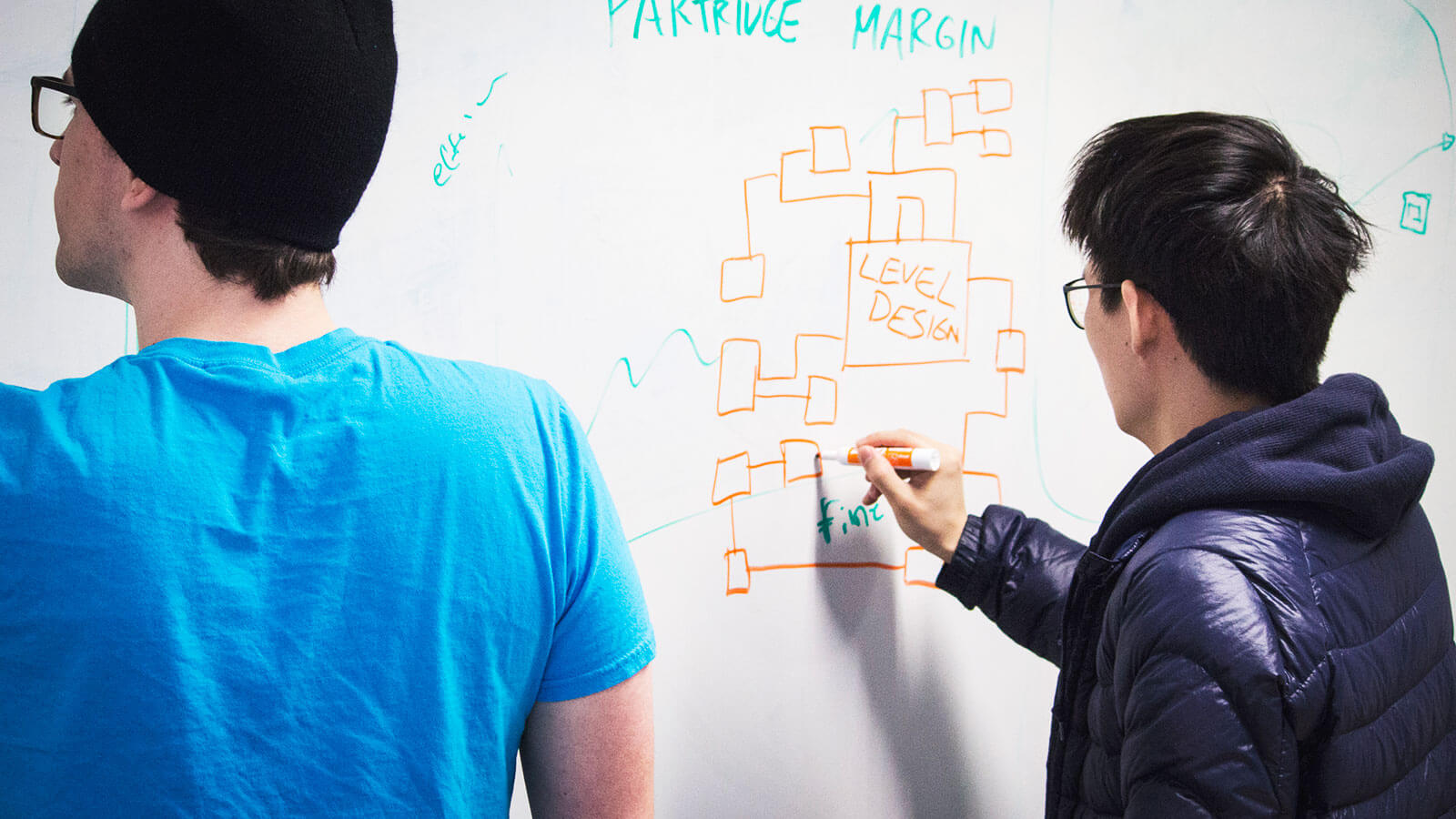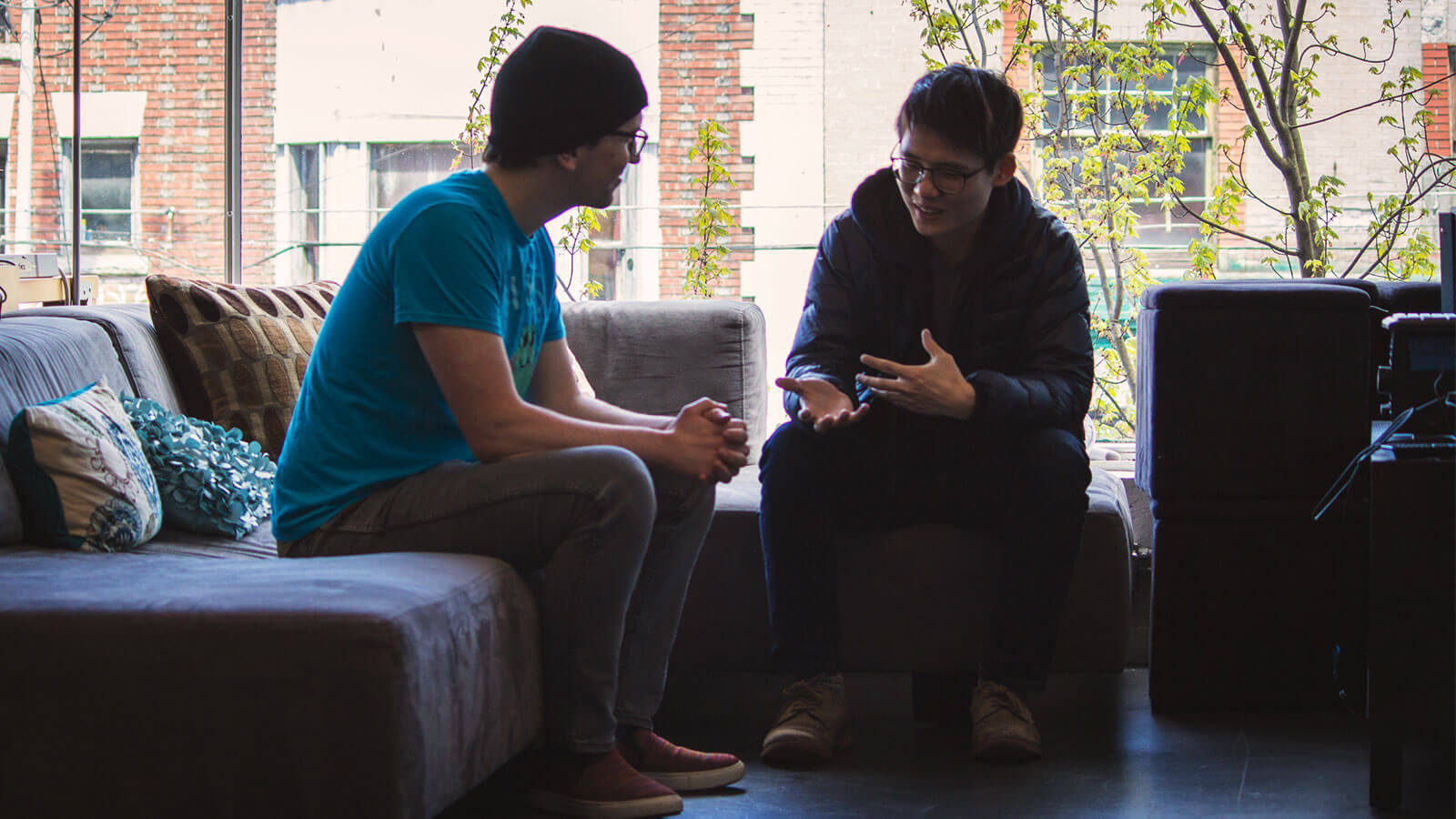Seattle Indies Spotlight: Pillow Castle Games
Pillow Castle Games is a lean indie studio working out of Indies Workshop in Capitol Hill. They’re currently working on Museum of Simulation Technology, a forced perspective first-person puzzle game that’s been nominated for awards at IGF, Indiecade, and Sense of Wonder Night. Today we interviewed their founder, Albert Shih, and lead game designer, Logan Fieth, who shared a little bit about their history, what they’re working on, and where they’re headed.

So, tell us a little bit about yourselves!
Albert
I grew up in Taiwan and came to the US for a computer science degree at Carnegie Mellon, then did a master’s degree in entertainment technology. After a while, I moved out to California to work on games and some contract jobs. Finally, while I was working on this game, we got it pitched and funded, so I moved up to Seattle.
Logan
I’m Logan and I’ve never worked a real job in my life. (laughs) I grew up here in Washington, not in Seattle, but south of Seattle — Maple Valley. Fortunately enough, DigiPen was in Washington, and since the Portal thing, I was pretty confident that I wanted to go to DigiPen. So I went there and got a degree in Game Design. I worked on some projects that were fairly successful there, and was able to do a Kickstarter from that after I graduated.
Albert
You also did that internship at 17-BIT.
Logan
Yeah! During school I also worked at 17-BIT on the initial prototype for their game, Galak-Z.

Albert, what brought you to Seattle from the East Coast?
Albert
Oh, it’s mainly because Logan was around here, and then I couldn’t get him to move anywhere else. (laughs)
How did you two meet?
Logan
It was through a friend I knew from school — Pohung. He was a producer on our student project game. He basically knows everyone (laughs). I first saw the tech demo for Museum of Simulation Technology when I was working on Perspective, and just sort of had it in the back of my mind. A few years later, there was a more polished version on Polygon that I saw. I was like, “Oh man this game is really cool”. So I asked Pohung if he knew the guy that was making the game, and he introduced me to Albert. We emailed a little bit and I said hey, I’m interested in working on the game. We had a Skype call the next day and Albert came up here—
Albert
Actually, the first time he talked to me, he was like, “Oh by the way, I have a whole zip folder full of ideas I sketched down. Feel free to check these out — you can use these if you want, but if not whatever.” I was like, “Cool.”


The first time he talked to me, he was like, ‘Oh by the way, I have a whole zip folder full of ideas I sketched down.’
How’s development on Museum of Simulation Technology progressing? When are you guys hoping to ship?
Albert
So-so. (laughs) We’re trying to get the game out in about a year or so. Possibly more than that. Current development is working on getting the entire structure of the game together. We’re trying to have the game playable from beginning to end, but still have rough assets just to see how that feels. We’ve spent, so far, a lot of time on just making new prototypes and polishing up on previous puzzles, as well as trying to figure out some of the larger questions in the game — what structure do we want to put things in, to make it more interesting? How do we include the art style and everything in that structure?
What was the inspiration behind Museum of Technology, especially the jazz music and museum setting?
Albert
My main inspiration was actually Antichamber. Antichamber constantly subverts your expectations of what the game is as well as what video games are. And to me, Museum of Simulation Technology is also striving on the same lines of trying to present something different that will make you say, “Oh, I didn’t know you could do that in video games.”
To the music and the settings, those are kind of just things that were interesting to me and worked well together. (laughs) Oftentimes you just choose what you like, and hopefully that’s interesting to people.
Logan
Yeah, we’ll sometimes throw out puzzles that might have been very neat, but just didn’t fit the feel of the game or our core pillars.

We’ll sometimes throw out puzzles that might have been very neat, but just didn’t fit the feel of the game or our core pillars.
Where did the idea for Museum of Simulation Technology’s scaling mechanic come from?
Albert
That was something I started working on when I was a student. There was a class about AI in game programming — for the final project, I said screw it, I’ll just do my own thing. I did add some birds flying in the sky in a flocking algorithm. That was my AI portion. (laughs) For the rest of it, I said, “I can work on this project for about a week and I can do anything. What do I want to do that’s really cool?” My constraints were that I couldn’t do any art, so the game had to be mostly gameplay focused.
Around that time, I was playing Portal, so I was thinking of a way to move objects, similar to Portal. So for example — one of the most obvious ideas was grabbing an object and having some sort of space in front of you, that you could rotate and move around that would change the direction of things. And that was a pretty bad idea and way too complicated, but from that idea I was like, “How do I simplify things? Well, what if I just grab things up and drop it down directly from that?”
When I thought of that, I didn’t really understand what that was or what it was called, which is forced perspective. I didn’t know what term that was until several months later, and then I was like, “Oh, that’s what it is”.
What does your tooling, workflow, and pipeline look like, especially for prototyping?
Albert
For game engine, we use Unity, and a few Unity assets that we use a lot right now. One’s ProBuilder, that helps us build a lot of the geometry and put textures on stuff really quickly.
Logan
It lets you also do 3D basic modeling right in Unity. There’s some instances where some of the basic shapes in Unity don’t have all the options, like if you want something a little more complex than a cube.
Albert
Besides that, we use different media tools. Photoshop. We haven’t really started up our art pipeline yet, so no Maya or Blender or anything.


Logan
Until a month ago, we were in a prototyping phase where we basically just did graybox levels of new mechanics that were related to the core mechanic.
Albert
It was basically 2 or 3 new levels of mechanics every week. And then after we did a round, we would playtest it, talk about how well it went, what parts are worth keeping, and what parts needed fixing.
Logan
What was interesting was the way we playtested that. We’d have people playtest the vertical stuff, which is the polished stuff you’ve played, and then after that the latest one or two prototype levels. So they’d get the basics, and then the new prototypes.
Albert
It was really important to have that vertical slice to start out with, so our prototypes didn’t just go everywhere. We’d use the slice to ground the other prototypes.
What does an average day at work look like to you guys?
Albert
It’s been different at different stages. Recently? We show up here, we have a production meeting at 10 that lasts for about half an hour. In that meeting we go over what stuff we’re going to work on. Plan what needs to get done, with our art director as well. Depending on the day we have another meeting in the afternoon, just as a feedback session. Along with that, we talk about design, art and story, whenever we need everyone to be on the same page or discuss something that comes up. All our other communications usually just happen on Slack.

What do you think is the hardest part of working in indie games? What warning would you give to people just starting out?
Albert
Be realistic about your expectations, especially in the current oversaturated indie games market. As an industry, we’re suddenly at a point where it’s so much easier to make games – so everyone has to step up their game a little bit to stand out.
Logan
I’m not 100% on this, but I think the oversaturation problem is a time problem and not a money problem — for consumers. Games are way too long, in my opinion. (laughs) I’m more willing to play a 2-3 hour game than a 50 hour game, which requires my entire Christmas break.
If you could do it all again from the start, what’s the best piece of advice you would give yourself?
Albert
That’s interesting. Give me five minutes. (laughs) I’m trying to think of the best answer ever.
Logan
Hmm. “Don’t take that first job offer out of impulse”. (laughs) Out of college, I didn’t really think about my options, and just took the first job I was offered. I didn’t end up working there very long.
Albert
Alright, I’ve thought of mine. If there’s something interesting about your game, you should really find out what that is. And a lot of times, it’s really hard to find out what that is. Because you might think it’s one thing, but it’s really another thing.

As an industry, we’re suddenly at a point where it’s so much easier to make games – so everyone has to step up their game a little bit to stand out.